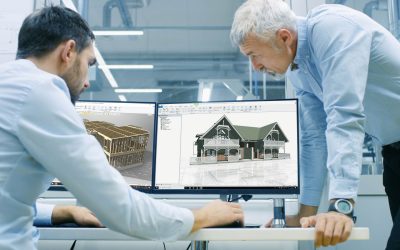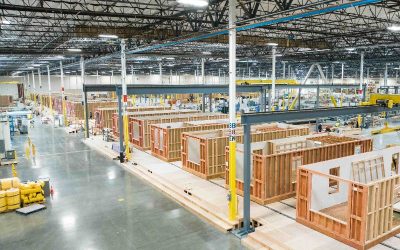The Facts About Off-site Construction — Blog 3: Volumetric Modular Construction
In this third blog of my series about off-site construction, I’ll discuss volumetric modular construction systems. This approach involves manufacturing 3D modules off-site and then arranging and connecting them at the job site to create the finished structure.
- Blog Post
- November 2022

- Pekka Moilanen
- Marketing Director
The History of Volumetric Modular Construction
While volumetric modular construction is among the fastest growing methods of off-site construction, the authors of “Technical Evolution of 3D Modular Construction from the Nineteenth Century to World War II” point out that engineers and builders have been experimenting with similar methods, including 3D modular off-site construction, since the nineteenth century. The article lists several examples of early 3D modular construction, including Hennebique´s concrete cabin for French railways (1896) and the Maisons Voisin (1919), which were 3D modular houses built by an airplane factory in France.
Volumetric construction is now being used for a range of applications for the residential, commercial, and industrial construction markets. Common use cases include multifamily residential buildings, large institutional structures such as healthcare facilities and conference centers, and hotels.
Benefits of Volumetric Modular Construction
A 2021 blog posted on NewEngineer explains the appeal of volumetric modular construction, stating that this method of off-site construction “comes into its own when there is a requirement to erect a building quickly, to a high-quality standard and at reduced costs.”
Expedited logistics and parallel sequencing are among the many scheduling benefits volumetric modular construction offers. The site preparation work, underground utilities, and foundation work can be completed concurrently, providing extremely advantageous scheduling options for builders and their clients. According to a 2019 report by McKinsey & Company, volumetric modular construction can allow for 20–50% schedule compression. Time savings of this magnitude yield many potential benefits.
The reduced construction time allows builders to potentially reduce construction loan durations and finance costs, increase labor efficiency by reducing downtime, and perhaps most importantly, reduce the number of opportunities for something to go wrong. Reduced time on-site equates to reduced risk of weather-related delays and other challenges.
Cost savings are a major benefit of volumetric modular construction projects. The NewEngineer article cited above indicates that modular construction can be 40–60% cheaper than traditional on-site construction.
With increased institutional and consumer interest in sustainability — not to mention rapidly rising raw material costs around the world — volumetric off-site construction is also gaining in popularity based on its sustainability and increased material efficiency. Offsite Construction Expo points to research indicating that the use of modular construction can result in up to a 90% reduction in waste.
Modern Approaches and Applications
The transformative potential of volumetric modular construction goes at least a step beyond other off-site construction methods because it eliminates so many environmental risks for builders. In many cases, modules are fabricated and shipped to the job site in a weather-tight condition, with interior finishes complete and secure inside each module.
Space M2, an innovative, Sweden-based commercial contractor specializing in volumetric modular construction, describes their production model as a modern car factory — but for houses. Rather than simply moving outdoor construction processes indoors, the company’s production model is organized and optimized for efficiency and integration, similar to the way modern automobile factories are designed. The outcome for Space M2’s customers is affordable, high-quality houses manufactured efficiently in optimal conditions. To learn more about Space M2, refer to this case study by my company, Vertex Systems.
Once the modules are constructed in the factory, they are shipped to the site, set in place, and connected. Offsite Construction Expo explains the conclusion of a typical volumetric construction project, stating that “mateline finishes, exterior systems such as cladding and roofing components and internal spaces like lobbies, stairwells, [and] elevator shafts” are completed on-site once the modules are arranged into the larger structure.
Inspections and punch lists are typically then completed so the owner can begin moving into the new building.
How Vertex Systems Accelerates Design and Production of Volumetric Modular Construction
Vertex BD is a building information modeling (BIM) software platform that automates design and manufacturing processes for off-site construction. Vertex Systems created this software to simplify the process of translating essential project information across all disciplines involved in producing each module. For any volumetric modular construction project, the plans, schedules, material reports, and manufacturing data can be created and saved within the software for distribution and coordination.
The software also offers powerful visualization tools. These detailed visualizations help our customers identify and correct design glitches and oversights before the modules go into production.
Learn More About Off-site Construction
The growth of volumetric modular construction may be the most important trend in off-site construction in the coming years, and a large number of our customers have already embraced this method. Check out our case studies to learn more about companies that are reshaping their markets with this innovative and sustainable approach to construction.
In the next blog in this series, I’ll cover hybrid off-site construction approaches, where volumetric, panelized, and other methods are used together to maximize design possibilities. I look forward to sharing more information with you then.
Related Stories
Best 3D construction software for professionals
Best 3D construction software for professionals 3D construction software has become a cornerstone of modern building projects, fundamentally transforming traditional construction practices. By enabling architects, engineers, and builders to create highly detailed,...
Leading construction design software for professionals
Leading construction design software for professionals In the ever-evolving construction industry, construction design software has become indispensable for streamlining workflows, enhancing accuracy, and improving collaboration. Among the available options, Vertex BD...
What is modular building design? – Unlock efficiency and precision
To fully unlock the potential of modular building design, it’s essential to utilize advanced tools that streamline the process from design to construction. While modular construction already offers significant advantages like faster timelines and cost savings, a tool like Vertex BD takes it further by integrating design and manufacturing into one seamless platform.




